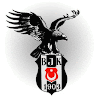Today we are all used to seeing the name Philips in uniform blue capital letters. It may appear in different sizes and colours but the basic shape of the seven capitalised letters is instantly recognisable wherever in the world we encounter it.

In the early years of the company, the representation of our name took many forms. One was an emblem formed by the initial letters of Philips &Co., and another was the word Philips printed on the glass of metal filament lamps.
In 1898, Anton Philips used a range of postcards showing the Dutch national costumes as marketing tools. Each letter of the word Philips was printed in a row of Light bulbs as at the top of every card. In the late 1920s, the name began to take on the form that we recognise today.
 The now familiar Philips waves and stars first appeared in 1926 on the packaging of miniwatt radio valves, as well as on the Philigraph, an early sound recording device. The waves symbolised radio waves while the stars represented the ether of the evening sky through which the radio waves would travel.
The now familiar Philips waves and stars first appeared in 1926 on the packaging of miniwatt radio valves, as well as on the Philigraph, an early sound recording device. The waves symbolised radio waves while the stars represented the ether of the evening sky through which the radio waves would travel.It wasn’t until 1930 that the four stars flanking the three waves came together for the first time in a now familiar circle. They appeared on radios and gramophones, which featured the circle, complete with stars and waves, as part of their design. The use of the circle emblem was then gradually extended to advertising material and other products.
By this time, our business activities were expanding rapidly and we wanted to find a trademark that would be uniquely Philips, but that would also avoid legal problems with the owners of other well-known circular emblems. It was this wish that resulted in the combination of the Philips circle and the wordmark within the now familiar shield emblem.
In 1938, the Philips shield made its first appearance. Although modified over the years, the basic design has remained constant ever since and, together with our word mark, gives us the distinctive identity we enjoy today.
Whilst the logo of the company has been consistent since the 1930s the way Philips has advertised and communicated to the outside world has varied. Up until the mid-1990s all advertising and marketing campaigns were carried out at product level on a local market basis. This led to many different campaigns running simultaneously, not giving a global representation of Philips as a global company.
In 1995 Philips introduced “Let’s make things better”. This was the first global theme and the first global campaign that encapsulated One Philips. This theme was rolled out globally and appeared in all markets and on all Philips products. This was also the first campaign that bought the whole company together,giving the employees a sense of belonging and providing a unified company look for an external audience.
“Let’s make things better” has served the company extremely well over the past nine years, but as the markets change and the company evolves so has the tagline. 2004 sees the new brand promise of “Sense and Simplicity” being delivered.
Philips is now looking at the entire brand perspective of the company, ranging from the online experience through to internal design processes. The new brand promise of “Sense and Simplicity” will help to take Philips forward as a healthcare, lifestyle and technology company, into new emerging and exciting markets.

Reference:http://www.philips.com/about/company/history/historyofthebrandmark/index.page













0 yorum:
Post a Comment